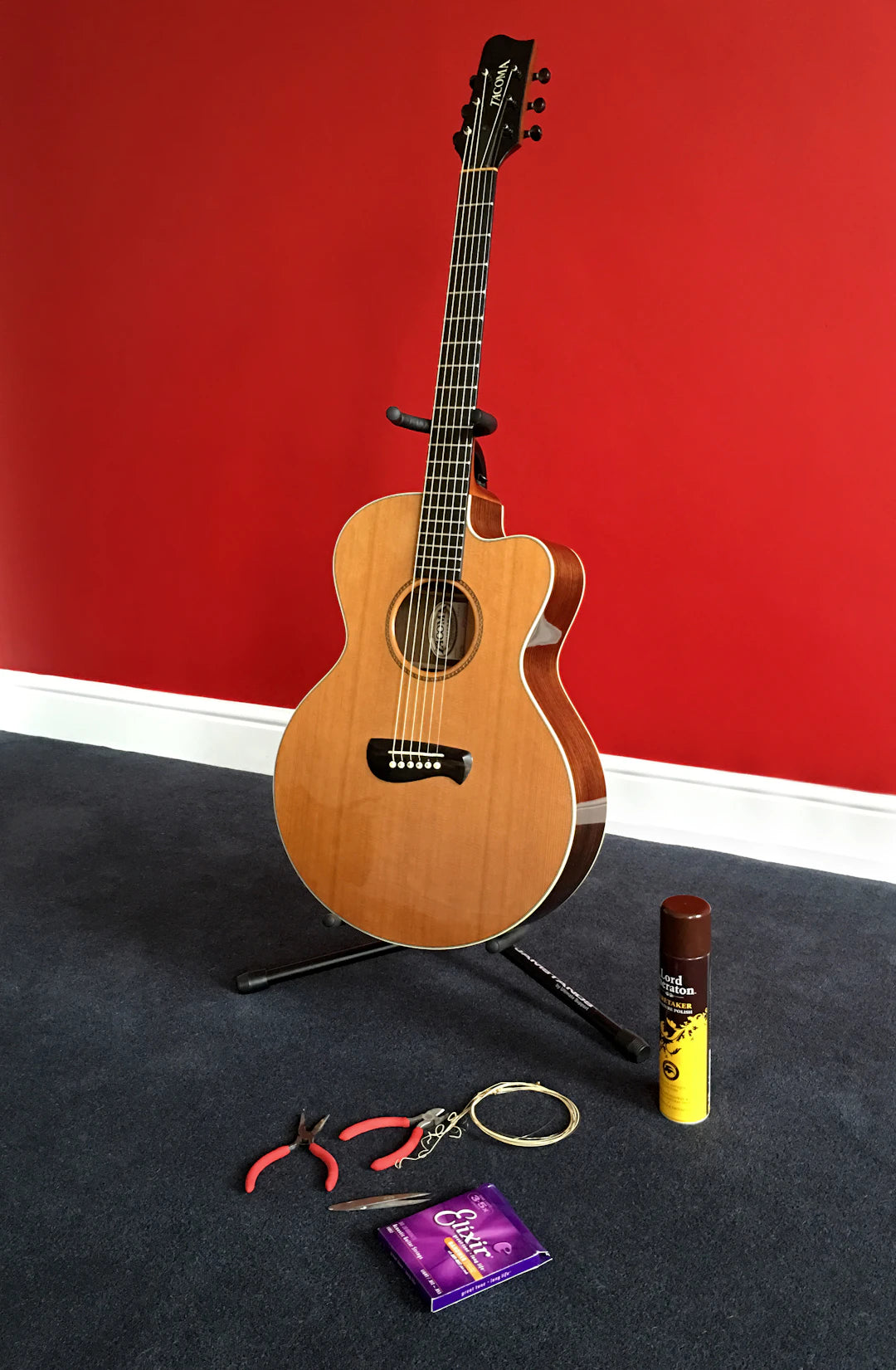Overview
Sanding is a crucial step in guitar restoration that removes surface imperfections, prepares for custom paint, enhances finish quality, and restores shape and contour. The process involves assessing the surface, sanding with varying grits, and cleaning up afterward. Common mistakes to avoid include applying too much pressure, skipping grits, and ignoring safety measures. After sanding, apply the finish, reassemble the guitar, and make final adjustments to achieve optimal playability and sound quality.
Frequently Asked Questions
1. Why is sanding important in guitar restoration?
2. What tools are necessary for sanding a guitar?
3. What common mistakes should be avoided when sanding a guitar?
4. What should I do after I finish sanding my guitar?
5. How does sanding affect the guitar's sound?
Restoring a guitar is not just about reviving its aesthetic qualities; it also involves enhancing its sound quality and playability. One of the foremost activities in this intricate process is sanding. While it may seem straightforward, sanding is critical in ensuring that your instrument not only looks good but delivers that clean Americana guitar tone that every musician desires. In this article, we will delve into the importance of sanding in guitar restoration and why it should be a key focus for any luthier or hobbyist.
Why Sanding Is Essential in Guitar Restoration
Sanding serves multiple purposes during the restoration of guitars. From removing old paint to preparing the surface for a flawless finish, it is an indispensable step in any restoration project. Let's look at some specific reasons why sanding is essential:
1. Removing Surface Imperfections
Over time, guitars may develop scratches, dents, and wear that affect their appearance and performance. Sanding helps remove these imperfections, providing a flat and even surface. This is particularly crucial for players who value aesthetics and sound quality alike, as a smoother surface facilitates better resonance and tuning stability.
2. Preparing for Custom Guitar Paint
When restoring a guitar, one may opt to give it a fresh coat of paint. For a polished look and feel, sanding before applying custom guitar paint is vital. Sanding not only helps in adhesion but also ensures that the paint goes on smoothly. A well-prepared surface avoids problems like peeling or bubbling, which can mar the final appearance of the instrument.
3. Enhancing Finish Quality
The finish of a guitar plays a huge role in its tonal characteristics. Sanding helps smooth out the surface which allows finishes—whether lacquer, polyurethane, or oil—to sit evenly. An even distribution of finish contributes to that sought-after clean Americana guitar tone, as a better application will enhance the guitar's natural tonal qualities.
4. Shape and Contour Restoration
Guitars are designed with precise contours and curves that affect their playability. Over time, these shapes may become compromised. Sanding is pivotal in reshaping and refining contours, ensuring that the guitar feels comfortable in a player’s hands. Properly contoured guitars enhance playability and allow for better projection of sound.
The Sanding Process: Step-by-Step
Now that we understand why sanding is essential, let's explore the step-by-step process involved in sanding a guitar effectively.
Preparation: Gather Your Tools
Before you start sanding, you will need to gather the right tools and materials. Key items include:
- Sanding blocks or orbital sanders
- A variety of sandpaper grits (coarse to fine)
- Protective eyewear
- Dust mask
- Clean cloths
Step 1: Assess the Surface
Begin by examining the guitar for scratches, dents, and the type of finish already applied. This will help you determine which grade of sandpaper to start with. For deeper imperfections, you might want to begin with a coarser grit, while lighter scratches can often be addressed with finer grits.
Step 2: Start Sanding
Using your chosen sandpaper, begin sanding with light and even pressure. Focus on the problem areas first but be careful not to go too deep. The goal is to gradually smooth out the surface without damaging the wood beneath. Always sand in the direction of the grain to avoid unsightly cross-grain scratches.
Step 3: Progress Through Grits
After addressing surface issues with coarse sandpaper, switch to progressively finer grits. This step is crucial: the finer grits eliminate any marks left by the coarser ones and improve the surface quality significantly. Continue sanding until the surface feels completely smooth to the touch.
Step 4: Clean Up
Once you've finished sanding, thoroughly clean the surface with a cloth to remove all dust and debris. Any residue can cause issues when applying custom guitar paint or finishes.
Common Sanding Mistakes to Avoid
Sanding might seem intuitive, but some common pitfalls can lead to unsatisfactory results. Be mindful of these mistakes to ensure your guitar restoration is a success:
1. Using Too Much Pressure
A common error that many make is applying too much pressure during sanding. This can create uneven surfaces or damage the wood. Light and consistent pressure is key.
2. Skipping Grits
Many restorers jump from a coarse grit directly to a fine grit, believing it will save time. However, skipping grits can leave scratches or marks on the surface that will remain visible even after finishing.
3. Ignoring Safety
Sandpaper dust can be harmful if inhaled, so it’s essential to wear a dust mask and safety goggles. don’t overlook this crucial aspect of the process.
After Sanding: What’s Next?
After completing the sanding process, the next steps are equally important to ensure a successful restoration project. Here’s what you should do:
1. Applying Finish
Choosing the right finish based on your desired tone and look is vital. Whether it’s a lacquer or an oil finish, apply it carefully, layer by layer. Take your time to ensure that each layer is evenly distributed and dry, enhancing both beauty and sound.
2. Reassembly
If you’ve disassembled your guitar for the sanding process, ensure that all components are replaced carefully. Check connections, hardware, and electronics to guarantee everything is in optimal working condition.
3. Final Adjustments
After reassembly, fine-tune your guitar. Adjust the action, intonation, and neck relief to optimize playability. This step is essential to achieve that perfect clean Americana guitar tone.
Final Touches: Bringing It All Together
As you wrap up your guitar restoration, remember that every detail counts. Quality sanding, choice of finish, and final adjustments combine to create a beautiful and functional instrument. Whether you aim to maintain its original qualities or enhance it through custom guitar paint, every decision should reflect your vision for the restoration.
Restoration is not merely a task; it's an art that can breathe new life into worn guitars. Remember, the heart of a great guitar lies not just in its design but in its sound. With careful sanding and a meticulous restoration process, you can unlock that signature tone and have an instrument you'll be proud to play for years to come.
Linked Product

Odyssey Solstice Tele Neck SC
The Odyssey Solstice Tele Neck SC pickup is designed to enhance the tonal quality of your Telecaster, offering a warm and articulate sound. Its hand-wound construction and Alnico V magnets ensure a balanced low end and clear highs, making it suitable for various genres such as country, blues, and Americana. This pickup provides a reliable option for musicians seeking to achieve classic Tele tones with modern performance consistency.
View Product










